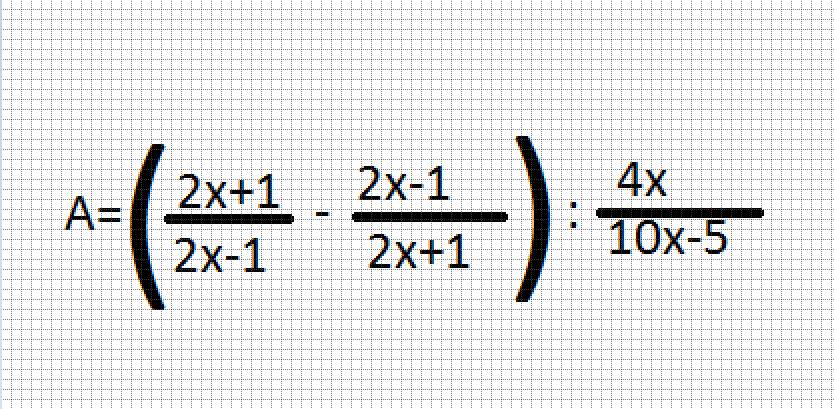 làm hết giúp e ạ
làm hết giúp e ạ
Hãy nhập câu hỏi của bạn vào đây, nếu là tài khoản VIP, bạn sẽ được ưu tiên trả lời.


a: \(=\dfrac{2x-9-x^2+9+2x^2-4x+x-2}{\left(x-3\right)\left(x-2\right)}\)
\(=\dfrac{x^2-x-2}{\left(x-3\right)\left(x-2\right)}=\dfrac{x+1}{x-3}\)
b: |Q|=1
=>x+1/x-3=1 hoặc x+1/x-3=-1
=>x+1=x-3 hoặc x+1=3-x
=>2x=2 và 1=-3(loại)
=>x=1(nhận)
c: Q nguyên khi x-3+4 chia hết cho x-3
=>\(x-3\in\left\{1;-1;2;-2;4;-4\right\}\)
=>\(x\in\left\{4;;5;1;7;-1\right\}\)

a: ĐKXĐ: x<>4; x<>-4
b: \(A=\dfrac{\left(x-4\right)\left(x-1\right)}{\left(x-4\right)\left(x+4\right)}=\dfrac{x-1}{x+4}\)
c: Để A nguyên thì x+4-5 chia hết cho x+4
=>\(x+4\in\left\{1;-1;5;-5\right\}\)
=>\(x\in\left\{-3;-5;1;-9\right\}\)

Câu 6:
ĐKXĐ: \(x\ne-\dfrac{1}{3}\)
Để \(\dfrac{9x+4}{3x+1}\in Z\) thì \(9x+4⋮3x+1\)
=>\(9x+3+1⋮3x+1\)
=>\(1⋮3x+1\)
=>\(3x+1\in\left\{1;-1\right\}\)
=>\(3x\in\left\{0;-2\right\}\)
=>\(x\in\left\{0;-\dfrac{2}{3}\right\}\)
mà x nguyên
nên x=0
Câu 2:
a: ĐKXĐ: \(x\notin\left\{2;-2;0\right\}\)
b: \(A=\left(\dfrac{1}{x+2}-\dfrac{2x}{4-x^2}+\dfrac{1}{x-2}\right)\cdot\dfrac{x^2-4x+4}{4x}\)
\(=\left(\dfrac{1}{x+2}+\dfrac{2x}{\left(x-2\right)\left(x+2\right)}+\dfrac{1}{x-2}\right)\cdot\dfrac{\left(x-2\right)^2}{4x}\)
\(=\dfrac{x-2+2x+x+2}{\left(x+2\right)\left(x-2\right)}\cdot\dfrac{\left(x-2\right)^2}{4x}\)
\(=\dfrac{4x\left(x-2\right)}{4x\left(x+2\right)}=\dfrac{x-2}{x+2}\)

a) ĐK:\(\begin{cases} x + 2≠0\\ x - 2≠0 \end{cases}\)⇔\(\begin{cases} x ≠ -2\\ x≠ 2 \end{cases}\)
Vậy biểu thức P xác định khi x≠ -2 và x≠ 2
b) P= \(\dfrac{3}{x+2}\)-\(\dfrac{2}{2-x}\)-\(\dfrac{8}{x^2-4}\)
P=\(\dfrac{3}{x+2}\)+\(\dfrac{2}{x-2}\)-\(\dfrac{8}{(x-2)(x+2)}\)
P= \(\dfrac{3(x-2)}{(x-2)(x+2)}\)+\(\dfrac{2(x+2)}{(x-2)(x+2)}\)-\(\dfrac{8}{(x-2)(x+2)}\)
P= \(\dfrac{3x-6+2x+4-8}{(x-2)(x+2)}\)
P=\(\dfrac{5x-10}{(x-2)(x+2)}\)
P=\(\dfrac{5(x-2)}{(x-2)(x+2)}\)
P=\(\dfrac{5}{x+2}\)
Vậy P=\(\dfrac{5}{x+2}\)

a: \(A=\left(\dfrac{x}{x^2-4}+\dfrac{4}{x-2}+\dfrac{1}{x+2}\right):\dfrac{3x+3}{x^2+2x}\)
\(=\dfrac{x+4x+8+x-2}{\left(x-2\right)\left(x+2\right)}\cdot\dfrac{x\left(x+2\right)}{3\left(x+1\right)}\)
\(=\dfrac{6\left(x+1\right)\cdot x\left(x+2\right)}{3\left(x+1\right)\left(x-2\right)\left(x+2\right)}\)
\(=\dfrac{2x}{x-2}\)

1. ĐKXĐ: \(x\ne\pm1\)
2. \(A=\left(\dfrac{x+1}{x-1}-\dfrac{x+3}{x+1}\right)\cdot\dfrac{x+1}{2}\)
\(=\dfrac{\left(x+1\right)^2-\left(x-3\right)\left(x-1\right)}{\left(x-1\right)\left(x+1\right)}\cdot\dfrac{x+1}{2}\)
\(=\dfrac{x^2+2x+1-x^2+4x-3}{\left(x-1\right)\left(x+1\right)}\cdot\dfrac{x+1}{2}\)
\(=\dfrac{6x-2}{\left(x-1\right)\left(x+1\right)}\cdot\dfrac{x+1}{2}\)
\(=\dfrac{2\left(x-3\right)\left(x+1\right)}{2\left(x-1\right)\left(x+1\right)}\)
\(=\dfrac{x-3}{x-1}\)
3. Tại x = 5, A có giá trị là:
\(\dfrac{5-3}{5-1}=\dfrac{1}{2}\)
4. \(A=\dfrac{x-3}{x-1}\) \(=\dfrac{x-1-3}{x-1}=1-\dfrac{3}{x-1}\)
Để A nguyên => \(3⋮\left(x-1\right)\) hay \(\left(x-1\right)\inƯ\left(3\right)=\left\{1;-1;3;-3\right\}\)
\(\Rightarrow\left\{{}\begin{matrix}x-1=1\\x-1=-1\\x-1=3\\x-1=-3\end{matrix}\right.\Rightarrow\left\{{}\begin{matrix}x=2\left(tmđk\right)\\x=0\left(tmđk\right)\\x=4\left(tmđk\right)\\x=-2\left(tmđk\right)\end{matrix}\right.\)
Vậy: A nguyên khi \(x=\left\{2;0;4;-2\right\}\)

\(\left(\dfrac{1}{x+2\sqrt{x}}-\dfrac{1}{\sqrt{x}+2}\right):\dfrac{1-\sqrt{x}}{x+4\sqrt[]{x}+4}\left(đk:x>0,x\ne1\right)\)
\(=\dfrac{1-\sqrt{x}}{\sqrt{x}\left(\sqrt{x}+2\right)}.\dfrac{\left(\sqrt[]{x}+2\right)^2}{1-\sqrt{x}}=\dfrac{\sqrt{x}+2}{\sqrt{x}}\)
Biểu thức \(=\dfrac{5}{3}\Leftrightarrow\dfrac{\sqrt{x}+2}{\sqrt{x}}=\dfrac{5}{3}\)
\(\Leftrightarrow3\sqrt{x}+6=5\sqrt{x}\Leftrightarrow2\sqrt{x}=6\Leftrightarrow\sqrt{x}=3\Leftrightarrow x=9\)

a: ĐKXĐ: x<>1/2; x<>-1/2; x<>0
b: \(A=\dfrac{4x^2+4x+1-4x^2+4x-1}{\left(2x-1\right)\left(2x+1\right)}\cdot\dfrac{5\left(2x-1\right)}{4x}\)
\(=\dfrac{8x}{4x}\cdot\dfrac{5}{2x+1}=\dfrac{10}{2x+1}\)





a: \(A=\left(\frac{x-4}{\sqrt{x}-2}+\frac{x\sqrt{x}-8}{4-x}\right):\frac{\left(\sqrt{x}-2\right)^2+2\sqrt{x}}{\sqrt{x}+2}\)
\(=\left(\frac{x-4}{\sqrt{x}-2}-\frac{\left(\sqrt{x}-2\right)\left(x+2\sqrt{x}+4\right)}{\left(\sqrt{x}-2\right)\left(\sqrt{x}+2\right)}\right):\frac{x-4\sqrt{x}+4+2\sqrt{x}}{\sqrt{x}+2}\)
\(=\left(\sqrt{x}+2-\frac{x+2\sqrt{x}+4}{\sqrt{x}+2}\right):\frac{x-2\sqrt{x}+4}{\sqrt{x}+2}\)
\(=\frac{\left(\sqrt{x}+2\right)^2-x-2\sqrt{x}-4}{\sqrt{x}+2}\cdot\frac{\sqrt{x}+2}{x-2\sqrt{x}+4}=\frac{x+4\sqrt{x}+4-x-2\sqrt{x}-4}{x-2\sqrt{x}+4}=\frac{2\sqrt{x}}{x-2\sqrt{x}+4}\)
b: \(A-1=\frac{2\sqrt{x}}{x-2\sqrt{x}+4}-1=\frac{2\sqrt{x}-x+2\sqrt{x}-4}{x-2\sqrt{x}+4}=\frac{-x+4\sqrt{x}-4}{x-2\sqrt{x}+1+3}\)
\(=-\frac{\left(x-4\sqrt{x}+4\right)}{\left(\sqrt{x}-1\right)^2+3}=\frac{-\left(\sqrt{x}-2\right)^2}{\left(\sqrt{x}-1\right)^2+3}<0\forall x\) thỏa mãn ĐKXĐ
=>A<1
c: Ta có: \(2\sqrt{x}\ge0\forall x\) thỏa mãn ĐKXĐ
\(x-2\sqrt{x}+4=\left(\sqrt{x}-1\right)^2+3\ge3\forall x\)
=>\(A=\frac{2\sqrt{x}}{x-2\sqrt{x}+4}\ge0\forall x\) thỏa mãn ĐKXĐ
=>0<=A<1
Để A là số nguyên thì A=0
=>x=0(nhận)